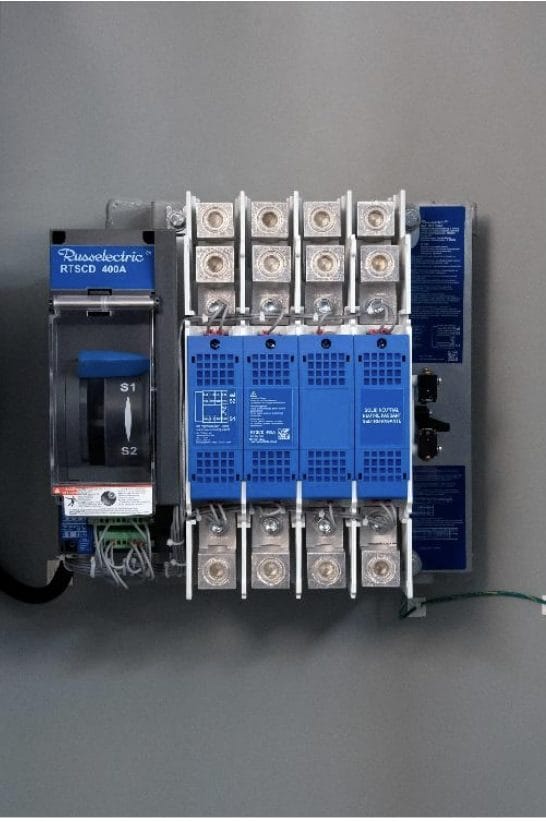Automatic transfer switches transfer electrical loads from a preferred power source to an alternate source when the preferred source’s voltage and/or frequency varies from preset limits. The switches also retransfer loads when optimal voltage and frequency in the preferred source is restored. Long used in mission-critical, life safety applications like healthcare facilities to ensure continuous power supply, the switches can also provide an important function in commercial applications during outages.
Commercial-duty switches understandably deliver fewer features than mission-critical ones; however, commercial-duty switches are not always built to the same standards of quality and reliability. Russelectric, A Siemens Business, an industry leader in the design, manufacture, and support of mission-critical automatic transfer switches, has responded to this need within the industry by developing a commercial duty ATS. Russelectric’s RTSCD offers the well-known and respected Russelectric quality and factory support in a simpler, easier-to-maintain, and more affordable package.
Basics of automatic transfer switches
An ATS is put in place for a loss of normal power from the usual power source; typically, utility power is supplied through power distribution equipment. When this loss of power is sensed, the ATS switches the building’s electrical loads to a secondary source, typically a generator. The ATS awaits the return of normal power, at which point it transitions the electrical loads back. This is done with little to no technician input, particularly in simpler commercial applications.
However, light industrial, commercial, and residential applications for automatic transfer switches, such as multi-family housing units, schools, office buildings, and other campus environments, do not require the same sophisticated features in a mission-critical ATS design. Nonetheless, they must still be reliable, easy to operate, and supported by technical experts for maintenance and repair.
These applications also tend to call for a small footprint as the pressure grows in several industries to use that same space to drive revenue. The market for commercial automatic transfer switches is currently growing faster than that of mission-critical systems, and the widespread demand for a low up-front cost alternative to mission-critical equipment has driven lower-quality engineering and design in the market.
Developing a commercial-grade option with mission-critical quality
Recognizing both the growing demand for commercial-duty ATS systems and the lack of reliability in several low-cost options on the market, market leader Russelectric decided to adapt their industry standard mission-critical ATS technology to meet the differing needs of these commercial applications. The resulting RTSCD ATS was designed with features similar to existing mission-critical ATS systems, ensuring consistency across the company’s overall product offerings.

Rated for applications with a current of 400 amps or less, the RTSCD delivers a lower price point than seen in the mission-critical space. The RTSCD features a smaller footprint, fewer individual part scripts within the product for simpler manufacturing and maintenance, and a simpler overall design. It is available in open-transition and delayed-transition formats and offers a manual transfer option with rapid arc interruption.
“Throughout the industry, we kept hearing from end users who wanted the same kind of quality of design that they have come to expect in mission-critical technology, but for lower amperages and at a lower price,” said Randy Adleman, Vice President of Commercial Operations at Russelectric. “Responding to that demand, we have introduced the RTSCD. Its design represents the same quality and performance contractors, consultants, and technicians have come to rely upon from Russelectric.”
Safety and maintenance
The RTSCD, like other Russelectric ATS designs, features operation from the front of the system for increased safety, as well as contacts that are easily accessible and inspectable from the front of the unit. Furthermore, with fewer components and moving parts than non-commercial ATS, the chance of failure is significantly reduced with the RTSCD design.
Even more so than other heavier-duty and higher-amperage designs, the RTSCD is engineered for ease of startup and operation to avoid the possibility of operator error. The RTSCD can be started up by users themselves without the need for an OEM technician. Its simplified design also benefits end users in terms of maintenance.
Conclusion
The need for more commercial-duty automatic transfer switches continues to grow as commercial, residential, and light industrial buildings begin to incorporate these products in their infrastructure designs to address the threat of power interruption. It has also become clear that the increase in demand for these products has created a push for lower-priced options, introducing often unreliable products into the marketplace. Responding to the need for reliable ATS technology at a reduced price point, Russelectric developed its modestly priced RTSCD automatic transfer switch, offering the same quality and performance that contractors, consultants, and technicians have come to reply upon from Russelectric since 1955.
The Editorial Team at Healthcare Business Today is made up of skilled healthcare writers and experts, led by our managing editor, Daniel Casciato, who has over 25 years of experience in healthcare writing. Since 1998, we have produced compelling and informative content for numerous publications, establishing ourselves as a trusted resource for health and wellness information. We offer readers access to fresh health, medicine, science, and technology developments and the latest in patient news, emphasizing how these developments affect our lives.








